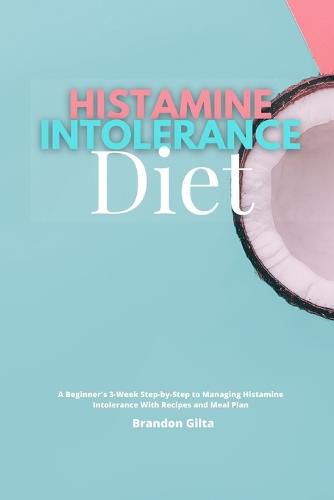Readings Newsletter
Become a Readings Member to make your shopping experience even easier.
Sign in or sign up for free!
You’re not far away from qualifying for FREE standard shipping within Australia
You’ve qualified for FREE standard shipping within Australia
The cart is loading…






This title is printed to order. This book may have been self-published. If so, we cannot guarantee the quality of the content. In the main most books will have gone through the editing process however some may not. We therefore suggest that you be aware of this before ordering this book. If in doubt check either the author or publisher’s details as we are unable to accept any returns unless they are faulty. Please contact us if you have any questions.
According to several studies and research conducted, histamine intolerance happens to 1% of the world population— 80% of which are of the middle-aged population group.
However, because histamine intolerance is characterized by the same symptoms as common allergies, most physicians diagnose these intolerance cases as allergies. Hence, it is called a pseudo-allergy or fake allergy.
Histamine was discovered by Dale and Laidlaw in 1910. And in 1932, it was found to be a mediator of allergic reactions which may be deadly for some people with severe cases. Now, histamine is defined as a substance produced by our immune system which acts as a defense mechanism against external bodies that may harm you. It is also responsible for allergic reactions such as tearing up, sneezing, and itching. Hence, the production of antihistamines which stops these allergic reactions for the comfort of people with allergies.
However, histamine levels in your body may rise, which may result in fluctuating blood pressure, disturbances to your heart rhythm, and neurological pathway disturbances. This condition is known as histamine intolerance— which may be fatal because histamine intolerance, as mentioned earlier in the text, is commonly misdiagnosed with other allergies. Thus, the patients are not given the proper treatments fo0r histamine intolerance.
Enteral histaminosis, commonly known as histamine intolerance, is a condition in which a person is sensitive to histamine-containing foods. It is a condition that has been just discovered this century and is associated with the inability to break down dietary histamine.
Histamine is only known as a chemical made by our bodies that is responsible for protecting our body from life-threatening allergens. But most people do not know that even foods and drinks contain histamine. So, this guide is made for people who have or may have enteral histaminosis. We will help you to know what your condition is and how to cope with it through the histamine intolerance diet.
After reading this guide, you will be able to answer the following questions: - What is histamine intolerance?
What are its symptoms?
How it develops
How to know if you are histamine intolerant
What lifestyle changes do you need to do if you are histamine intolerant?
What food and drinks do you need to watch out for
$9.00 standard shipping within Australia
FREE standard shipping within Australia for orders over $100.00
Express & International shipping calculated at checkout
This title is printed to order. This book may have been self-published. If so, we cannot guarantee the quality of the content. In the main most books will have gone through the editing process however some may not. We therefore suggest that you be aware of this before ordering this book. If in doubt check either the author or publisher’s details as we are unable to accept any returns unless they are faulty. Please contact us if you have any questions.
According to several studies and research conducted, histamine intolerance happens to 1% of the world population— 80% of which are of the middle-aged population group.
However, because histamine intolerance is characterized by the same symptoms as common allergies, most physicians diagnose these intolerance cases as allergies. Hence, it is called a pseudo-allergy or fake allergy.
Histamine was discovered by Dale and Laidlaw in 1910. And in 1932, it was found to be a mediator of allergic reactions which may be deadly for some people with severe cases. Now, histamine is defined as a substance produced by our immune system which acts as a defense mechanism against external bodies that may harm you. It is also responsible for allergic reactions such as tearing up, sneezing, and itching. Hence, the production of antihistamines which stops these allergic reactions for the comfort of people with allergies.
However, histamine levels in your body may rise, which may result in fluctuating blood pressure, disturbances to your heart rhythm, and neurological pathway disturbances. This condition is known as histamine intolerance— which may be fatal because histamine intolerance, as mentioned earlier in the text, is commonly misdiagnosed with other allergies. Thus, the patients are not given the proper treatments fo0r histamine intolerance.
Enteral histaminosis, commonly known as histamine intolerance, is a condition in which a person is sensitive to histamine-containing foods. It is a condition that has been just discovered this century and is associated with the inability to break down dietary histamine.
Histamine is only known as a chemical made by our bodies that is responsible for protecting our body from life-threatening allergens. But most people do not know that even foods and drinks contain histamine. So, this guide is made for people who have or may have enteral histaminosis. We will help you to know what your condition is and how to cope with it through the histamine intolerance diet.
After reading this guide, you will be able to answer the following questions: - What is histamine intolerance?
What are its symptoms?
How it develops
How to know if you are histamine intolerant
What lifestyle changes do you need to do if you are histamine intolerant?
What food and drinks do you need to watch out for